Dive into the fascinating world of Kiyomizu-dera, one of Kyoto’s most cherished landmarks. This guide will unravel the temple’s rich history, cultural significance, and provide practical tips for your visit. Whether you’re a traveler, a history buff, or a cultural enthusiast, this article has everything you need to make the most of your experience.
The Historical Significance of Kiyomizu-dera
Founded in 778 AD, Kiyomizu-dera has been a cornerstone of Japanese Buddhism for over a millennium. The temple, dedicated to Kannon, the Goddess of Mercy, reflects the spiritual practices of the Heian period. Its name, meaning “Pure Water Temple,” originates from the nearby Otowa Waterfall, believed to have sacred properties. Recognized as a UNESCO World Heritage Site in 1994, Kiyomizu-dera has endured fires and wars, symbolizing resilience and cultural continuity.
Architectural Marvels of Kiyomizu-dera

The temple’s iconic wooden stage, jutting out 13 meters above the hillside, is an architectural masterpiece. Constructed without nails, the stage is supported by interlocking wooden beams—a testament to ancient Japanese engineering. The Hondo (Main Hall) features traditional thatched roofs and houses a revered statue of Kannon. Don’t miss the Otowa Waterfall below, where visitors can sip from three streams for blessings of health, longevity, and success.
Planning Your Visit to Kiyomizu-dera
- Location: 1-294 Kiyomizu, Higashiyama Ward, Kyoto.
- Access: A 20-minute bus ride from Kyoto Station or a scenic walk through the charming Higashiyama district.
- Opening Hours: Typically from 6:00 AM to 6:00 PM, extended during special events.
- Entrance Fee: ¥400 for adults.
- Best Times to Visit: Spring (cherry blossoms) and autumn (red foliage).
- Nearby Attractions: Stroll through Ninenzaka and Sannenzaka streets, visit Kodai-ji Temple, or shop for traditional crafts.

Seasonal Highlights and Events at Kiyomizu-dera
Experience the temple’s charm through the seasons:
- Spring: Cherry blossoms adorn the temple grounds.
- Summer: Traditional Tanabata Festival decorations.
- Autumn: Illuminations showcase fiery autumn leaves.
- Winter: Serene snow-covered landscapes.
Exploring the Surrounding Area

- Ninenzaka & Sannenzaka Streets: These historic lanes offer quaint shops and tea houses.
- Chion-in Temple: A short walk away, this grand temple complements your Kyoto exploration.
- Souvenir Hunting: Find Kiyomizu-yaki pottery, local sweets, and prayer charms.
Kiyomizu-dera in Modern Media and Culture
Featured in films, anime, and literature, Kiyomizu-dera continues to inspire creators. It symbolizes tradition in works like Memoirs of a Geisha and countless Japanese dramas, and its photogenic qualities have made it a staple of travel documentaries.
FAQs About Kiyomizu-dera
What is Kiyomizu-dera famous for?
Its wooden stage, sacred waterfall, and stunning seasonal views.
How do I get to Kiyomizu-dera from Kyoto Station?
Take Bus 100 or 206 to Gojo-zaka or Kiyomizu-michi.
Is there an entrance fee for Kiyomizu-dera?
Yes, ¥400 for adults and ¥200 for children.
Tips for a Memorable Experience

- Photography: The view from the stage is unparalleled; visit early to avoid crowds.
- Local Food: Try yatsuhashi (cinnamon rice crackers) from nearby vendors.
- Etiquette: Respect sacred areas, and dress modestly.











